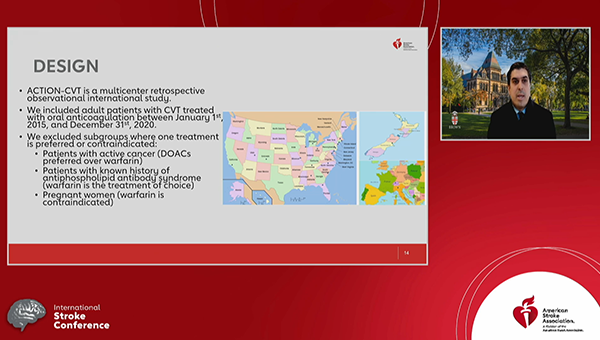ACTION-CVT: DOACs Look Like a Good Option for Cerebral Venous Thrombosis
The results provide reassurance that using DOACs for patients with CVT “is not an unreasonable approach,” one expert says.

Direct oral anticoagulants (DOACs) seem to be just as effective as warfarin for the treatment of cerebral venous thrombosis (CVT), with better safety, the large observational ACTION-CVT study indicates.
Rates of recurrent venous thrombosis, death, and partial/complete recanalization were not significantly different between anticoagulant types, but DOACs were associated with a lower risk of major hemorrhage (adjusted HR 0.35; 95% CI 0.15-0.81), Shadi Yaghi, MD (Brown University, Providence, RI), reported Thursday at the International Stroke Conference 2022.
The findings, published simultaneously online in Stroke, provide support for the shift away from warfarin and toward DOACs that has been seen in practice in recent years despite the absence of solid randomized data in the setting of CVT, an uncommon cause of stroke typically seen in younger patients.
Still, the “findings need confirmation by ongoing large prospective studies or randomized trials,” Yaghi said at a media briefing. Those include DOAC-CVT, an international observational study that aims to enroll 500 patients, and SECRET, a 50-patient pilot trial pitting rivaroxaban (Xarelto; Bayer/Janssen) against standard-of-care anticoagulation.
Thalia Field, MD (Vancouver Stroke Program, University of British Columbia, Canada), principal investigator of the SECRET trial, explained that 5 or 6 years ago, physicians were hesitant to use DOACs for CVT because of the lack of evidence to support it and minimal clinical experience. But that has changed in the ensuing years. Although there still has not been a definitive trial, findings from RE-SPECT CVT and a substudy of the EINSTEIN-Jr trial have provided reassurance about the safety of DOACs in this setting, coinciding with increasing use of the drugs in practice.
ACTION-CVT is informative because it provides additional evidence on real-world use of DOACs in a large cohort of patients, Field told TCTMD.
“It’s also nice to have results that reiterate what we would have expected from the randomized trial literature in venous thromboembolism,” she said. “I’m not particularly surprised that there’s comparable efficacy with regards to recurrent venous thromboembolism, and I’m not surprised that there’s a slight reduction in risk of hemorrhage with the DOACs.”
The study has limitations, Field noted, pointing to the retrospective design; the lack of adjudication of endpoints, particularly for radiological outcomes; and an “unusual” definition for recurrent events that includes extension of venous thrombus. “Regardless, despite the flaws that you would expect in conducting a pragmatic retrospective study that’s very large pretty quickly, I think it’s a pretty valuable study to provide additional reassurance that using DOACs is not an unreasonable approach in patients with CVT,” she commented.
ACTION-CVT
Investigators from 27 centers across the United States, New Zealand, Italy, and Switzerland collaborated to create a large cohort for ACTION-CVT, retrospectively enrolling 1,025 adult patients with CVT treated between 2015 and 2020. After exclusion of groups in which DOACs or warfarin are preferred or contraindicated—patients with active cancer (a DOAC is usually preferred), those with a known history of antiphospholipid antibody syndrome (warfarin is the treatment of choice), and pregnant women (warfarin is contraindicated)—there were 845 patients (mean age 45 years; 65% women) left for the analysis. Data were obtained from medical records.
Slightly more than half of patients (52%) were treated with warfarin only, 33% with DOACs only, and 15% with both treatments at some point.
Through a median follow-up of 345 days, recurrent cerebral/systemic venous thrombosis, major hemorrhage, and death occurred at rates of 5.68, 3.77, and 1.84 per 100 patient-years, respectively. Of the subset of patients included in the recanalization analysis, 37% had complete, 48% had partial, and 15% had no recanalization.
On the efficacy outcomes, DOAC therapy was not associated with a difference in risk compared with warfarin:
- Recurrent venous thrombosis (adjusted HR 0.94; 95% CI 0.51-1.73)
- Death (adjusted HR 0.71; 95% CI 0.24-2.08)
- Partial/complete recanalization (adjusted OR 0.92; 95% CI 0.48-1.73)
The rate of major hemorrhage, however, was lower with DOACs. The findings, Yaghi reported, held up across various sensitivity analyses and after propensity score matching.
He acknowledged the limitations of the study, including the retrospective design, the nonblinded outcome adjudication, and the possibility of residual treatment-by-indication bias. Nonetheless, “our study suggests that DOACs represent a reasonable alternative to warfarin in patients with CVT,” the researchers write in their paper, adding that further studies are needed to assess whether use of the more-expensive agents is cost-effective in this setting.
‘Potential to Change Practice’
Commenting on the findings at the media briefing, Tudor Jovin, MD (Cooper University Health Care, Camden, NJ), said ACTION-CVT “really confirms what we know in general about DOACs versus warfarin” when it comes to stroke prevention in atrial fibrillation and to the treatment of thromboembolic disease in general—ie, similar efficacy and better safety. The fact that only 33% of patients in this study received DOACs reflects the reluctance of physicians to use them to treat CVT, Jovin said, adding, “I think this has potential to change practice.”
Field, who wrote an editorial accompanying the Stroke publication with Johnathon Gorman, MD (Vancouver Stroke Program, University of British Columbia), pointed out that CVT is uncommon enough—accounting for only about 1% of all strokes—that it’s difficult to produce high-quality evidence to inform its management.
Large international collaborations—like the one used for ACTION-CVT—are important to produce high-quality research, Field said, noting that enthusiasm in this area had been growing around the world even before CVT was identified as a rare consequence of vaccine-induced immune thrombotic thrombocytopenia (VITT) associated with some of the COVID-19 vaccines.
As for the impact on practice, Field said use of DOACs for CVT varies across countries, with physicians in some areas being more hesitant to prescribe them than their colleagues elsewhere. The lack of firm guidance from the professional societies might be contributing. European guidelines don’t specifically recommend DOACs, whereas US guidance was last updated more than a decade ago when DOACs were not yet widely available. The first Canadian CVT recommendations are still being developed, Field said.
For now, a study like ACTION-CVT “provides reassurance” for physicians who are increasingly reaching for DOACs, Field said, indicating that the quest for more-definitive data should continue: “I think it’s always good to aspire to have the highest-quality evidence to inform your practice, but in the absence of that, I think there is a growing body of underpowered trials and observational literature to inform the way that we practice.”
Todd Neale is the Associate News Editor for TCTMD and a Senior Medical Journalist. He got his start in journalism at …
Read Full BioSources
Yaghi S, Shu L, Bakradze E, et al. Direct oral anticoagulants versus warfarin in the treatment of cerebral venous thrombosis (ACTION-CVT): a multicenter international study. Stroke. 2022;Epub ahead of print.
Gorman JB, Field TS. ACTION-CVT: are the findings ACTIONable? Stroke. 2022;Epub ahead of print.
Disclosures
- This research has been supported partially by Italian Ministry of Health Ricerca Corrente – IRCCS MultiMedica.
- Yaghi reports a noncompensated relationship with Medtronic.
- Field reports receiving support from the Sauder Family/Heart and Stroke Professorship of Stroke Research, Michael Smith Health Research BC, and the Heart and Stroke Foundation of Canada; being the principal investigator of the SECRET Trial, which received in-kind study medication from Bayer Canada; receiving honoraria from HLS Therapeutics outside the submitted work; and serving on the board of Destine Health.
- Gorman reports support from a Friedman Award for Scholars in Health from the University of British Columbia and the Vancouver General Hospital Foundation.





Comments